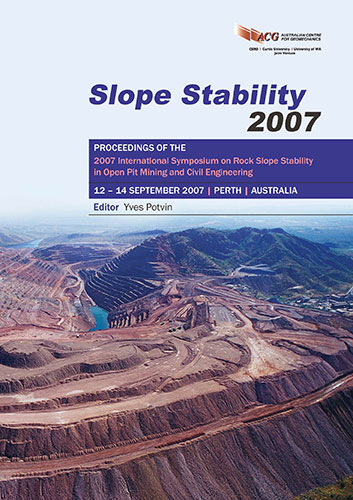Risk Evaluation of Slope Failure at the Chuquicamata Mine

|
Authors: Tapia, A; Contreras, LF; Jefferies, M; Steffen, O |
DOI https://doi.org/10.36487/ACG_repo/708_32
Cite As:
Tapia, A, Contreras, LF, Jefferies, M & Steffen, O 2007, 'Risk Evaluation of Slope Failure at the Chuquicamata Mine', in Y Potvin (ed.), Slope Stability 2007: Proceedings of the 2007 International Symposium on Rock Slope Stability in Open Pit Mining and Civil Engineering, Australian Centre for Geomechanics, Perth, pp. 477-495, https://doi.org/10.36487/ACG_repo/708_32
Abstract:
The possibility of increasing the pit slope angles of the Chuquicamata Mine as the pit approaches its planned closure is being considered. Compared to the conventional mine design, the slope steepening is understood to raise the net present value (NPV) of the mine, but also, attracts an increase in possible adverse outcomes related to the increase in the likelihood of slope failures. A quantitative risk evaluation was undertaken to provide information to assist the mine management in their decision by: defining risks in terms of safety and economics, quantifying risk level for different slope configurations and comparing results against industry norms. The approach included three main tasks: (1) evaluation of the total probability of failure (POF) representative of the stability conditions of slopes. (2) Evaluation of the consequences of slope failure on safety of personnel. (3) Evaluation of the consequences of slope failure in terms of economic losses associated with impact on equipment and production, including the Force Majeure event situation (major economic loss affecting the continuation of the mine business). Options for risk mitigation are also discussed briefly. The main purpose of this paper is to present the process of a risk evaluation of mine slopes; therefore, the emphasis has been put on the methodology followed rather than on the actual results obtained.
References:
Australian Geomechanics Society (2000) Landslide risk management concepts and guidelines. AGS Sub-Committee on
Landslide Risk Management, Sydney, Australia, March.
Baecher, G.B. and Christian, J.T. (2003) Reliability and statistics in geotechnical engineering, Wiley, Chichester, UK.
Health and Safety Executive (2001) Reducing risks, protecting people – HSE’s decision-making process. HSE books.
UK.
Hoek, E. and Bray, J.W. (1974) Rock slope engineering. Institution of Mining and Metallurgy, London.
Itasca Consulting Group, Inc. (2004) UDEC (Universal Distinct Element Code). Version 4.0. Minneapolis: Itasca
Consulting Group, Inc.
Morgan, M.G. and Henrion, M. (1990) Uncertainty: a guide to dealing with uncertainty in quantitative risk and policy
analysis. Cambridge University Press.
Pine, R.J. and Roberds, W.J. (2005) A risk-based approach for the design of rock slopes subject to multiple failure
modes – illustrated by a case study in Hong Kong. International Journal of Rock Mechanics and Mining
Sciences 42 (2005), Elsevier Ltd., pp. 261 – 275.
Sjoberg, J. (1999) Analysis of large scale rock slopes. Doctoral Thesis, Lulea University of Technology, Division of
Rock Mechanics, Lulea, Sweden.
Steffen, O.K.H. (1997) Planning of open pit mines on a risk basis. Journal of SAIMM, March/April.
Vick, S.G. (2002) Degrees of belief: subjective probability and engineering judgment. ASCE, Reston, Va.
Rock Slope Stability
Slope Stability 2007, Perth, Australia 495
© Copyright 2025, Australian Centre for Geomechanics (ACG), The University of Western Australia. All rights reserved.
View copyright/legal information
Please direct any queries or error reports to repository-acg@uwa.edu.au
View copyright/legal information
Please direct any queries or error reports to repository-acg@uwa.edu.au